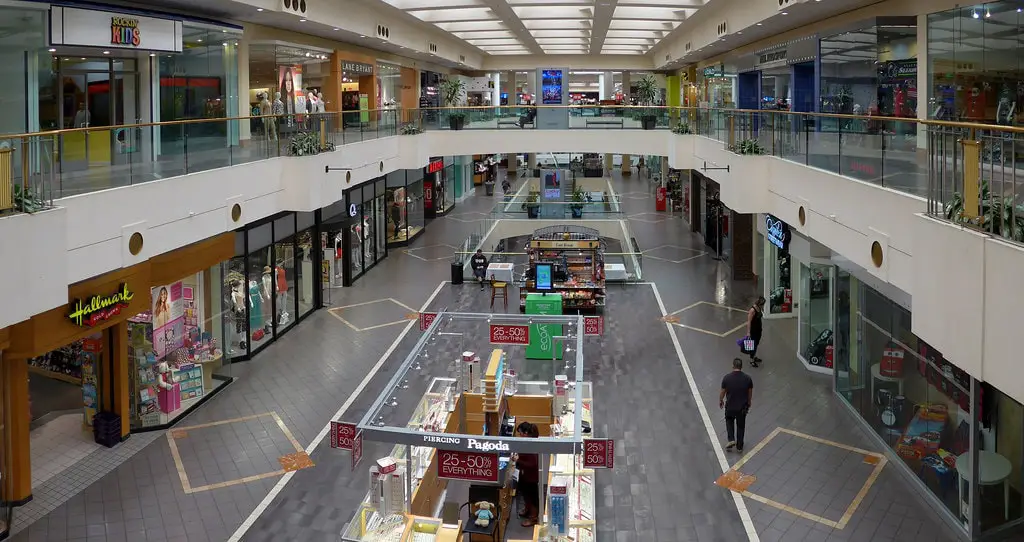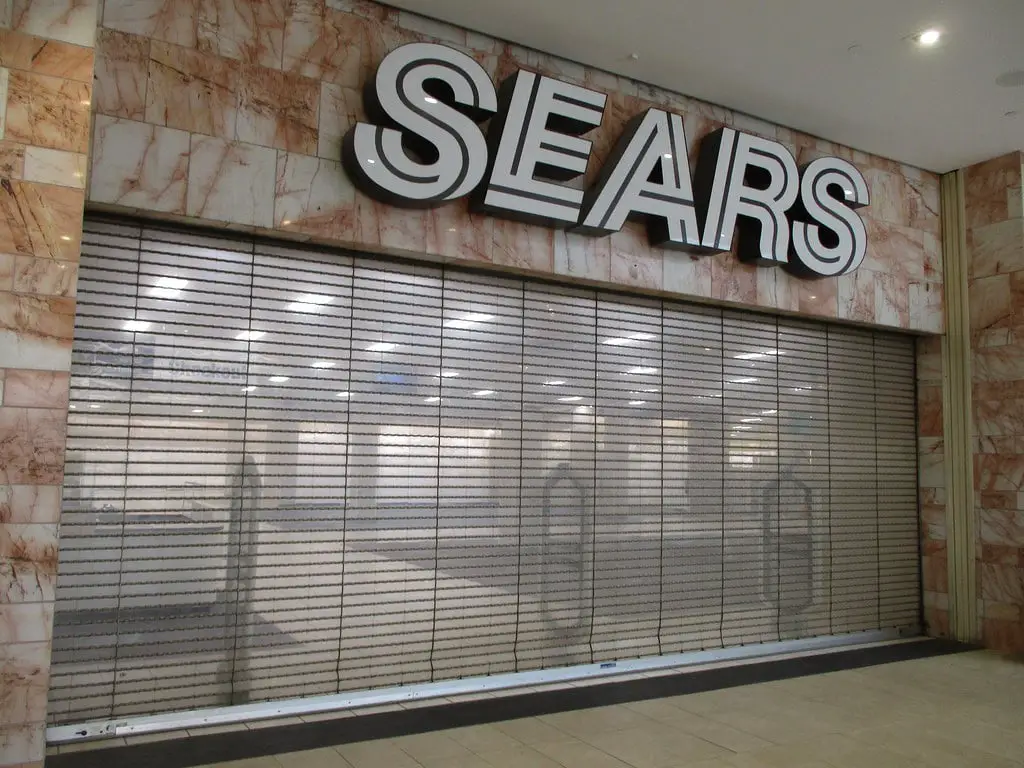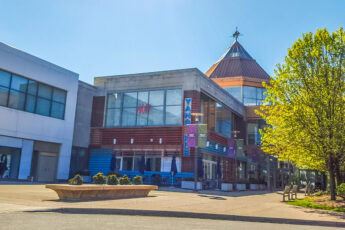The Golden Mall Era (1967-1989)
The Golden Mall was a pedestrianized shopping area in downtown Burbank, California. Established in 1967, the mall transformed San Fernando Boulevard from Tujunga Avenue to Magnolia Boulevard into a bustling retail hub. It attracted local shoppers and was home to various small businesses and retail stores.
During the 1970s and 1980s, efforts to revitalize Golden Mall emerged. Developers and city planners eyed a vacant 40-acre parcel at the northern end of the mall, hoping to create a new retail destination. In 1979, developer Ernst Hahn proposed a large downtown mall with five anchors.
However, financial issues plagued the project, leading to scaled-back plans. By 1987, the Burbank Towncenter plan collapsed after Robinsons, a key anchor tenant, withdrew from the project.
For a short time, The Walt Disney Company explored the idea of building a large shopping center on the site. However, in 1988, rising costs caused Disney to abandon the project. The city then passed the development to European mall developer Haagen Co., setting the stage for future developments.
These early attempts to revitalize Golden Mall highlight the challenges of large-scale retail development in Burbank during the late 20th century.
The Golden Mall eventually paved the way for the creation of the Burbank Town Center as developers continued to explore new ways to attract shoppers to downtown Burbank.
The Birth of Burbank Town Center (1991)
In 1991, Burbank Town Center opened its doors. The mall stood on the same spot where earlier redevelopment efforts had struggled. Alexander Haagen, a European mall developer, took on the project.
The mall officially launched on August 21, 1991, with anchors Sears and Mervyn’s leading the charge. It wasn’t a full-scale opening; only 20 stores were ready for business on day one. But this was the first phase, and more was to come.
The plans for Burbank Town Center included a variety of attractions beyond shopping. A branch of the Natural History Museum of Los Angeles County was planned and set to open in 1992, though it ended up being delayed.
The grand design also included a food court, a movie theater, a 300-room hotel, and 1 million square feet of office space. However, delays and changes in the retail landscape meant some of these plans took longer than expected or never fully materialized.
The mall quickly became a focal point in Burbank, drawing both locals and visitors. It brought new retail names into the area and aimed to compete with other shopping destinations in the region.
In a bid to keep pace with the evolving retail environment, Burbank Town Center tried to incorporate entertainment and dining options. However, these initial years were more about establishing a foundation than achieving commercial success.

Struggles and Changes in the 1990s
The 1990s weren’t easy for Burbank Town Center. Despite the initial buzz, the mall struggled to keep up with expectations. Bullock’s opened in August 1992, but by 1996, Macy’s replaced Bullock’s as an anchor after a rebranding effort.
This change was more than just a name swap; it reflected broader challenges in maintaining the mall’s appeal in a competitive retail market.
Foot traffic and sales didn’t hit the levels many had hoped for, leading to talks of renovation and even a name change. Mall owners recognize the need to adapt, but shifting a mall’s image is never simple.
A remodeling plan in the late 1990s aimed to refresh the space’s look and feel, incorporating more natural materials like stone, which was a popular trend at the time.
Another blow came with the closure of several stores that had been part of the mall’s original lineup. By the end of the decade, Burbank Town Center was at a crossroads, trying to find its footing amid a changing retail landscape.
The shopping experience had to evolve, and this period set the stage for the transformations that followed in the 2000s.
Ownership Changes and Renovations (2003-2010)
In 2003, Crown Realty bought Burbank Town Center for $110 million. They saw the need for change and planned a major renovation to update the mall’s image.
The goal was clear: make the mall more appealing and drive up sales. By August 2003, Crown Realty announced an overhaul that included new materials like stone to give the mall a fresher, more modern look.
The name “Media City Center” didn’t stick around. By late 2004, the mall officially became Burbank Town Center. This rebranding aimed to shed any lingering perceptions of the mall as outdated. Yet, challenges persisted. The retail market was shifting, and big box stores were beginning to feel the pressure.
One of the original anchors, Mervyn’s, closed its doors in 2008 as the entire chain shut down across California. This left a large vacancy that wasn’t easy to fill.
In 2010, Burlington Coat Factory took over the former Mervyn’s space. The mall tried to adapt to the changing retail landscape by attracting new tenants like Ashley HomeStore, which moved into the space vacated by Circuit City in 2008.
Despite these efforts, the mall still struggled to regain its early momentum. The renovations helped, but they weren’t enough to fully turn things around.

The Decline of Traditional Retail Anchors
The 2010s saw more turbulence for Burbank Town Center. IKEA, one of the mall’s major draws, announced in 2016 that it would move to a larger location nearby. The old IKEA closed its doors on February 4, 2017.
The loss of IKEA was a big hit for the mall, as it had been a steady source of traffic for years. The space left behind was substantial, and filling it proved challenging.
In January 2018, developers announced a $350 million plan to redevelop the former IKEA site. The plan included dividing the space into smaller retail units, hotel rooms, and apartments.
This mixed-use approach was an attempt to revitalize the area and bring in new customers. The developers also allocated $60 million for further renovations to the main mall itself.
Meanwhile, Sears, the last of the original anchors, announced it would close in September 2022. This closure marked the end of an era. The mall’s attempts to adapt reflect broader trends in retail, where big-box stores are facing intense pressure from online shopping and changing consumer habits.
Cultural Impact and Media Appearances
Burbank Town Center has always been more than just a mall. Its location near major studios like Warner Bros. and Walt Disney Studios has made it a popular filming spot.
Over the years, it has appeared in various movies and TV shows. This connection to the entertainment industry has kept the mall in the public eye, even as its retail side struggled.
In 2020, the old IKEA building was used as a set for the Netflix game show “Floor is Lava.” This was another example of how the mall’s location and available space made it attractive for production crews.
Even though the mall was facing challenges on the retail front, it still had a role to play in Burbank’s cultural scene.

Sears’ Quiet Comeback at Burbank Town Center (2023-2024)
Sears, once a giant in American retail, unexpectedly returned to Burbank Town Center in late 2023. This store, which had closed a year earlier, reopened its doors quietly, without much fanfare, but it quickly caught the attention of the community.
The newly revived Sears in Burbank looks almost like a throwback to its earlier days. It features a mix of home goods, appliances, and clothing spread across three floors.
What stands out is the uncertainty surrounding Sears’ future. While the reopening in Burbank and another location in Union Gap, Washington, suggest a potential strategy to reuse large, vacant retail spaces, experts remain skeptical.
Many believe these moves might be more about occupying empty properties than a genuine attempt to revive the brand. Despite this, some shoppers and employees remain hopeful that the brand can find its footing in the modern retail landscape.
The reopening of these stores indicates that Sears still holds a place in American retail, even if its future remains unclear. As of now, the Burbank store stands as a test, a small experiment that might determine the next steps for one of the oldest names in retail.









My wife and I have lived in and around Burbank for over 70 years. We had to laugh at the ultra liberal slant you put on that “White Elephant” mall. It was one big fat joke from beginning to end.
Your reporter omitted several facts that really contributed to the decline of that pig-in-a-poke. For instance, the cost overruns, the poor completion of the spaces, the high rents and extra charges that were forced upon the tenants. And each and every time the place was sold or remannaged the rents skyrocketed. Renters left in droves, unable to survive under the new management, who mostly slapped on a new coat of paint and changed the name. Covid, perpetrated by more extreme left liberals, also caused many businesses throughout Burbank to close and never reopen. The management of the mall failed in their responsibility to attract and keep shops that provide quality at a reasonable price, but due to the exorbitant rents, many businesses either had to raise their prices or move to another less expensive location. I know that this information is not in line with the popular opinions of the left and their creative rewriting of history, but the truth always is.
Maybe you should fact check your articles prior to publication.
Thank you for sharing your perspective. It sounds like you have some deep concerns about the history and management of the mall. I can understand your frustration with how things have been handled over the years.